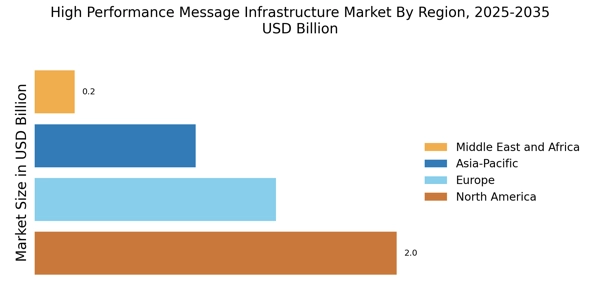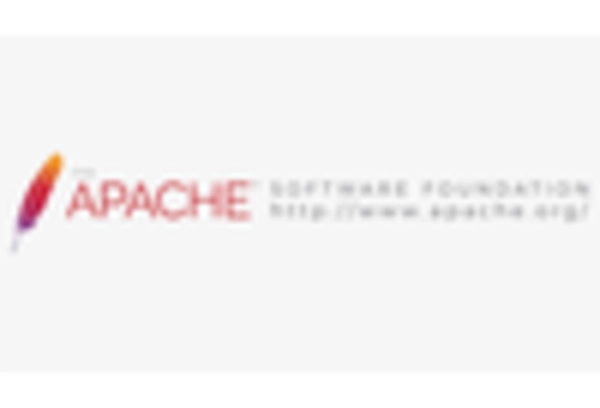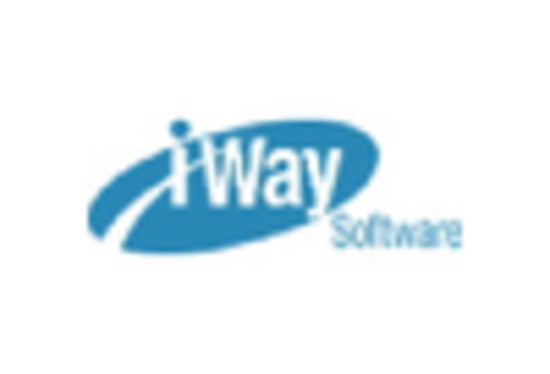Increased Focus on Data Security
As cyber threats continue to evolve, the High Performance Message Infrastructure Market is witnessing an increased focus on data security and compliance. Organizations are becoming more aware of the potential risks associated with data breaches and are prioritizing secure messaging solutions to protect sensitive information. Regulatory requirements, such as GDPR and HIPAA, are further compelling businesses to adopt robust security measures within their messaging infrastructures. The market is responding to this demand by offering solutions that incorporate end-to-end encryption, secure access controls, and comprehensive auditing capabilities. This heightened emphasis on security not only safeguards organizational data but also enhances customer trust and loyalty. As a result, the demand for secure high-performance messaging solutions is anticipated to grow, contributing to the overall expansion of the market.
Integration of Advanced Technologies
The integration of advanced technologies such as artificial intelligence and machine learning into the High Performance Message Infrastructure Market is becoming increasingly prevalent. These technologies facilitate enhanced data processing capabilities, enabling organizations to analyze vast amounts of information in real-time. The incorporation of AI-driven analytics allows for improved decision-making and predictive capabilities, which are essential in today’s fast-paced business landscape. Furthermore, the market is witnessing a shift towards automation, where messaging systems can autonomously manage and route messages based on predefined criteria. This trend not only optimizes resource utilization but also reduces operational costs. As organizations continue to adopt these advanced technologies, the demand for high-performance messaging solutions is expected to rise, thereby driving market growth.
Expansion of IoT and Connected Devices
The proliferation of Internet of Things (IoT) devices is significantly influencing the High Performance Message Infrastructure Market. As more devices become interconnected, the need for efficient messaging solutions to facilitate communication between these devices is paramount. The market is witnessing a surge in demand for messaging infrastructures that can handle the vast amounts of data generated by IoT applications. This trend is particularly relevant in sectors such as manufacturing, transportation, and smart cities, where real-time data exchange is essential for operational efficiency. Market analysts project that the number of connected devices will reach billions in the coming years, further driving the need for high-performance messaging solutions. Consequently, the expansion of IoT is expected to be a key driver of growth within the messaging infrastructure market.
Growing Demand for Real-Time Communication
The High Performance Message Infrastructure Market is experiencing a notable surge in demand for real-time communication solutions. Organizations across various sectors are increasingly recognizing the necessity for instantaneous data exchange to enhance operational efficiency and decision-making processes. This trend is particularly evident in industries such as finance, healthcare, and telecommunications, where timely information can significantly impact outcomes. According to recent data, the market for real-time messaging solutions is projected to grow at a compound annual growth rate of approximately 20% over the next five years. This growth is driven by the need for businesses to remain competitive in an environment where speed and accuracy are paramount. As a result, investments in high-performance messaging infrastructure are likely to escalate, further propelling the market forward.
Rising Need for Scalability and Flexibility
In the current business environment, the need for scalability and flexibility within the High Performance Message Infrastructure Market is becoming increasingly critical. Organizations are seeking messaging solutions that can easily adapt to fluctuating workloads and evolving business requirements. This demand is particularly pronounced among enterprises that are expanding their operations or transitioning to hybrid cloud environments. The ability to scale messaging infrastructure without significant downtime or resource investment is a key factor influencing purchasing decisions. Market data suggests that companies prioritizing scalable messaging solutions are likely to experience improved operational agility and reduced time-to-market for new products and services. Consequently, the emphasis on scalable and flexible messaging infrastructures is expected to drive substantial growth in the market.

















Leave a Comment